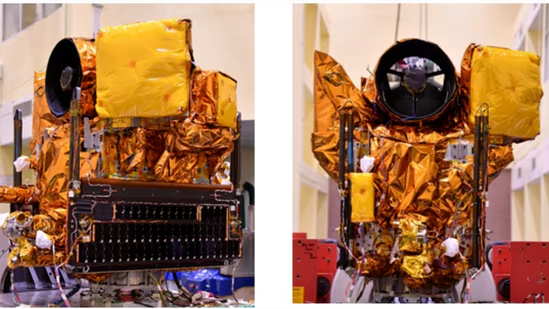**The EOS-08 Satellite Details**
– **Orbit and Altitude**
The EOS-08 satellite is designed to operate in a Circular Low Earth Orbit (LEO) at an altitude of 475 kilometers.
– **Purpose**
This orbit allows the satellite to effectively monitor and collect data about Earth’s surface, supporting various Earth observation applications.
**In Short**
– **EOS-08 Mission Objectives**
The EOS-08 mission aims to design and develop a microsatellite, integrate payload instruments with the microsatellite bus, and advance new technologies for future satellites.
– **Payload Details**
EOS-08 will carry three key payloads into space.
– **Significance**
The mission represents a significant advancement in satellite technology and marks the third development flight of the Small Satellite Launch Vehicle (SSLV) by the Indian Space Research Organisation (Isro).

**In Short**
– **EOS-08 Payloads**
EOS-08, built on the Microsat/IMS-1 bus, will carry three key payloads, including the Electro Optical Infrared Payload (EOIR). This payload is designed to capture images in the Mid-Wave IR (MIR) and Long-Wave IR (LWIR) bands, usable both day and night.
– **Applications**
The satellite’s applications include satellite-based surveillance, disaster monitoring, environmental monitoring, fire detection, volcanic activity observation, and industrial disaster monitoring.
– **GNSS-R Payload**
The Global Navigation Satellite System-Reflectometry (GNSS-R) payload will demonstrate its capabilities for ocean surface wind analysis, soil moisture assessment, cryosphere studies over the Himalayan region, flood detection, and inland waterbody detection.
– **SiC UV Dosimeter**
The SiC UV Dosimeter will monitor UV irradiance at the viewport of the Crew Module in the Gaganyaan Mission and act as a high-dose alarm sensor for gamma radiation.
– **Satellite Specifications**
The EOS-08 satellite is designed to operate in a Circular Low Earth Orbit (LEO) at an altitude of 475 km with an inclination of 37.4°. It has a mission life of one year and weighs approximately 175.5 kg. It features an advanced integrated avionics system, known as the Communication, Baseband, Storage, and Positioning (CBSP) Package
– **Integrated Avionics System**
The Communication, Baseband, Storage, and Positioning (CBSP) Package integrates multiple functions into a single efficient unit, capable of supporting up to 400 GB of data storage.
– **Technological Innovations**
The EOS-08 mission highlights advancements like X-band data transmission, advanced battery management systems, and enhanced thermal management materials.
– **Indigenisation Efforts**
The mission features indigenous solar cell fabrication processes and employs a Nano-Star Sensor for microsatellite applications.
– **SSLV Capabilities**
The Small Satellite Launch Vehicle (SSLV) represents a significant advancement in India’s space capabilities, providing a cost-effective and flexible option for deploying small satellites into low Earth orbit.
– **SSLV Design Purpose**
The Small Satellite Launch Vehicle (SSLV) addresses the rising global demand for small satellite launches.
– **Payload Capacity**
It can carry up to 500 kg to Low Earth Orbit (LEO), meeting a key need in the satellite launch market.
– **Advantages**
The SSLV’s compact size and quick turnaround time make it well-suited for deploying smaller satellites, which are increasingly used for Earth observation, communications, and scientific research.